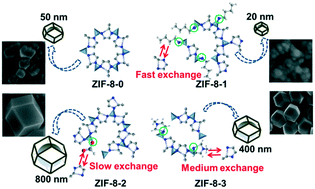Controlling the size of a Zn-MOF through ligand exchange and pore-tailored ZnO assemblies for size-selective gas sensing†
Abstract
Metal–organic framework (MOF) materials with controlled microstructures have become popular in the last few decades. In this study, Zn-MOF precursors with diverse crystallinity and particle size (20–800 nm) were synthesized using an accelerating or retarding nucleation process by introducing various secondary ligands, which were employed as modulators in the coordination and ligand exchange equilibria according to their different acidity coefficients. Thus, the pore size of MOF-derived ZnO clusters was different, resulting in diverse gas sensing properties. Moreover, large precursor-derived ZnO-(2 and 3) assemblies with the micropore sizes of 1 nm and 0.75 nm showed size-selective sensing and better performance, which exhibited a higher and fast response (4 s) to butanone and n-butanol with the lengths of 0.664 nm and 0.499 nm, respectively, and a low limit of detection (0.1 ppm). This simple method of controlling the nucleation of MOFs and the pore size of ZnO assemblies paved a new way towards the design of the microstructure of MOF-based functional materials.



 Please wait while we load your content...
Please wait while we load your content...